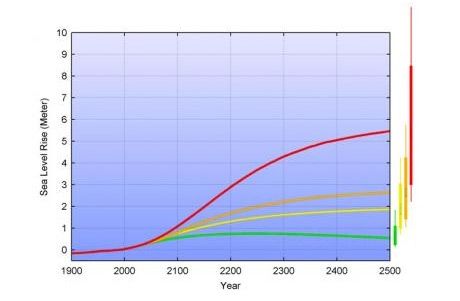New publications
Sea level rise will continue for 500 years
Last reviewed: 30.06.2025

All iLive content is medically reviewed or fact checked to ensure as much factual accuracy as possible.
We have strict sourcing guidelines and only link to reputable media sites, academic research institutions and, whenever possible, medically peer reviewed studies. Note that the numbers in parentheses ([1], [2], etc.) are clickable links to these studies.
If you feel that any of our content is inaccurate, out-of-date, or otherwise questionable, please select it and press Ctrl + Enter.
Rising sea levels in the coming centuries are perhaps one of the most catastrophic consequences of rising temperatures. Enormous economic costs, social upheaval and forced migration are what this will lead to.
"Based on the current situation, we predict that sea level change will continue for 500 years," says study author Aslak Grinsted from the Centre for Glaciology and Climatology at the Niels Bohr Institute at the University of Copenhagen (Denmark).

The graph shows how sea levels would change under four scenarios. The green, yellow, and orange lines represent scenarios in which greenhouse gas emissions would stabilize in 10, 30, and 70 years, respectively. The red line assumes emissions would continue to rise. (Image courtesy of the authors.)
Working with colleagues in England and China, he developed a model based on what was happening with greenhouse gas emissions, aerosols and air pollution. The model was then adjusted backwards to match real measurements, and then used to predict the future of sea level rise.
The research team envisioned four scenarios. In the worst-case scenario (emissions continue to rise), sea levels would rise by 1.1 m by 2100 and by 5.5 m by 2500. Even in the most optimistic scenario (new technological advances, active international cooperation to stop greenhouse gas emissions and air pollution), sea levels would continue to rise. By 2100, they would rise by 60 cm, and by 2500, by 1.8 m.
Under two more realistic scenarios that assume stabilization of emissions and pollution, sea levels would rise by about 75 cm by 2100 and by 2 m by 2500.
“The sea rose by an average of 2mm a year in the 20th century, but this is accelerating and in recent decades sea levels have risen about 70% faster,” says Mr Grinstead. “Even if greenhouse gas emissions stop, sea level rise will continue to accelerate for several centuries because of the delayed response of the sea and ice caps. It could be 400 years before we get back to the rate of the 20th century.”
